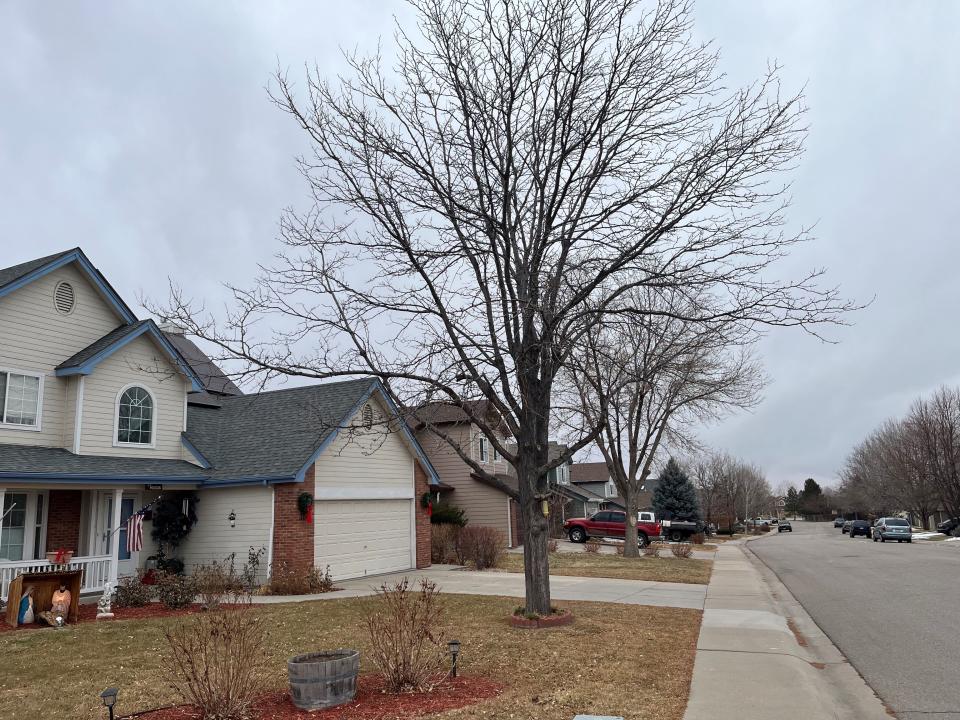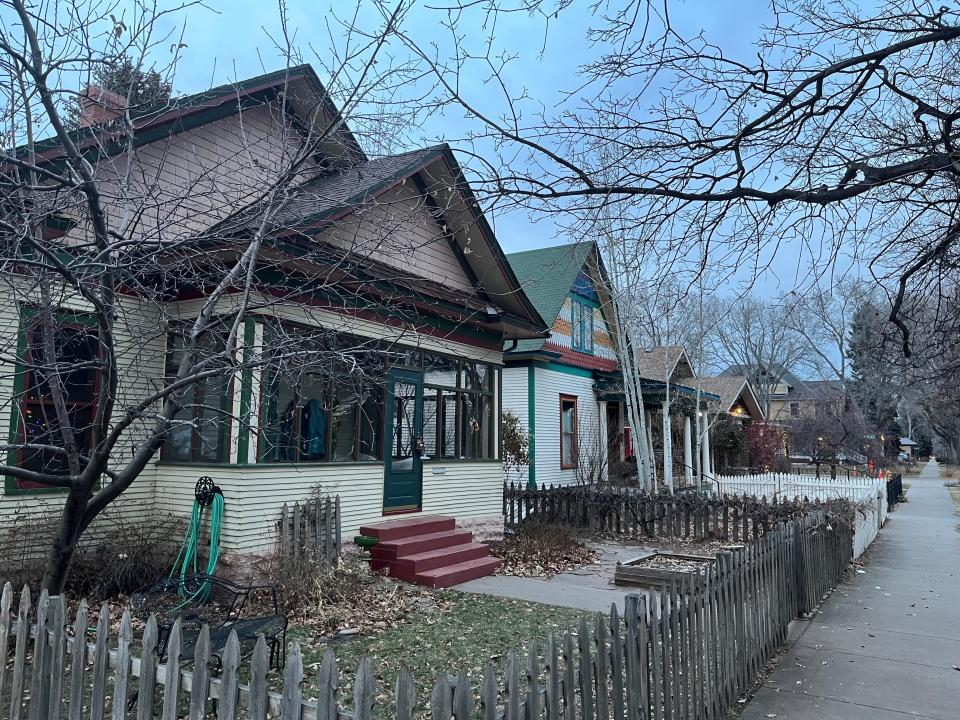Fort Collins land use code still taking shape, but here's what it's starting to look like
A new proposed land use code for Fort Collins is beginning to take shape, seven months after a different update was repealed due to resident concerns.
The land use code forms the rules for development in the city and ultimately determines things like how many units a lot can hold, which housing types will be allowed in neighborhoods, what the parking requirements will be and when projects get reviewed by the public. It influences the feel of a neighborhood, its density, activity and aesthetics.
On Tuesday, City Council held a final work session to dig through proposals, which were influenced by public feedback since the repeal. So far, a majority of council is amenable to 23 out of 33 ideas that staff presented to them to address resident concerns with the repealed code.
The ideas are meant to address concerns about increased density and neighborhood character/quality but still allow for more housing and incentivize development of affordable housing.
Four of these alternatives are still causing some hesitation among council members, and six others won't be included in a draft of the proposed land use code.
The draft code will go up for a vote at the Oct. 3 council meeting, but first it'll go to the Planning & Zoning Commission for feedback.
In the meantime, "we still have a process for community input" on what the draft should include, said Caryn Champine, the city's director of planning, development and transportation.
The public can weigh in by contacting their City Council representatives, speaking during City Council meetings or at the P&Z meeting at 6 p.m. Sept. 27.
Here's a look at what council is and isn't agreeable to including in the code and what's causing uncertainty still.
These items are getting a green light to be included in a draft of the land use code
Mostly, council is supportive of allowing accessory dwelling units, or ADUs, across the city where a single-family unit exists, with some conditions in some zones.
Not all council members are in favor of all the alternatives presented, but Kelly Ohlson has expressed the most concern about and lack of support for key items in the proposed code.
On Tuesday, he said the city should leave built-out, existing neighborhoods alone, particularly low-density ones. "I'm a hard no."
He said many of the plans should be executed in some parts of the city, but not in existing neighborhoods.
If a majority of council said they were supportive or open to one of the alternatives, then it has a spot in the draft land use code for now, Champine said.
There are also items from the repealed code that are expected to be in the draft but were not part of City Council discussion at the July and August work sessions, which were focused on items that drew the most concern from residents.
Here are 23 revisited items a majority of council said they were comfortable including in the draft of the land use code.
First, it'll be helpful to know what neighborhoods are in what zones: https://gisweb.fcgov.com/HTML5Viewer/Index.html?Viewer=FCMaps&layerTheme=Zoning%20Districts
For low-density residential neighborhoods (RL)
These items apply only to the residential, low-density (RL) zoning, which comprises 23% of the city. These are single-family-home neighborhoods like English Ranch in the southeast, University Acres near UCHealth Poudre Valley Hospital, Quail Hollow on the west and Greenbriar in the north. Right now, only single-family homes are allowed in this zone.

These rules will go into a draft code:
Allowing two units maximum (either a duplex or a house with ADU) on a lot.
Allowing an ADU with a single unit dwelling but not with a duplex.
Requiring ADU properties to be owner occupied.
Limiting ADUs to one story when there's no alley.
Allowing duplexes only if one of these conditions is met: The lot is 100 feet or wider, one unit is an affordable housing unit, the duplex integrates or converts an existing structure, the lot is within a quarter mile of current or future high-frequency traffic.
For the low-density neighborhood conservation zone (NCL)
The next item would apply only to the zoning district known as NCL, or neighborhood conservation, low density, which comprises 1.4% of the city. It includes the Historic Fort Collins High School neighborhood, the neighborhood surrounding Laurel Elementary School and many homes north and east of City Park. Carriage houses, the current code's term for ADUs, are already allowed for lots over 12,000 square feet in this zone.

A majority of council is amenable to:
Decreasing minimum lot size to 4,500 square feet (to allow existing lots under 5,000 square feet to come into compliance).
Allowing two units on lots up to 6,000 square feet.
Restricting ADU heights to the height of the primary building.
For the medium density neighborhood conservation zone (NCM)
This item would apply only to the zoning district known as NCM, or neighborhood conservation, medium density, which comprises 1.5% of the city. It includes neighborhoods like the one southeast of the Old Town Library, University Park east of Colorado State University and portions of Old Town West. Already allowed in this zone are carriage houses (ADUs) as long as a lot is 10,000 square feet and up to four units if a lot is 6,000 square feet.
These items are set to be in the draft proposal:
Decreasing minimum lot size to 4,500 square feet (for compliance).
Allowing three units maximum on lots up to 6,000 square feet.
Allowing five units maximum on lots larger than 6,000 square feet.
Here's what HOA control is looking like
In the repealed code, there were many concerns about homeowners associations not having tools to control building standards for ADUs. After reviewing four alternatives, council members generally were comfortable with two of them:
Allowing a homeowners association, or HOA, to regulate whether an ADU can be detached from the home or must be attached.
Specifying that HOAs can regulate aesthetics (color, window placement, height, materials, etc.) within the bounds of their existing rules.
Here's how the code would aim to increase affordable housing
These options would "create a citywide incentive structure that would both allow affordable housing providers to build more affordable units as well as encourage private developers to contribute to the city’s affordable housing needs by using incentives to close the gap between market rate homes and affordable homes," according to a staff presentation to council.
"These alternatives do not require affordable housing to be built; rather, they increase the opportunity for affordable housing to be built across the community while attempting to incorporate community desire to maintain neighborhood character," the report said.
Here are the suggestions council generally agreed with:
Expanding affordable housing incentives citywide and calibrating market-feasible incentives for ownership and rental. This would expand incentives to a greater percentage of the city than what exists now and could relax parking requirements for projects.
Extending the required affordability term for affordable housing from 20 years to 50/60 years to ensure that affordable housing continues to remain affordable into the future.
Updating the definitions of affordable housing to match market need for ownership and rental. Currently the code says affordable housing is defined as anyone making below 80% of area median income, or AMI. The proposal is to include separate definitions for owner-occupied or renter-occupied, such as 60% for rentals and 100% for owners because those are where the needs are greatest.
Here's how parking requirements could be relaxed
These options "attempt to address concerns about parking congestion in neighborhoods while recognizing the potential trade-off of fewer housing units," according to a staff report.
Council generally is willing to proceed with:
Reducing parking requirements for multiunit developments: One bedroom would require one parking space rather than 1.5. Two bedrooms would require 1.5 spaces rather than 1.75.
Reducing parking requirements for affordable housing only if the development has seven or more units.
Requiring one parking space for an ADU.
Allowing a tandem parking space to count only for an ADU or extra occupancy. (Tandem parking is when a driveway includes enough space for a car to be parked behind another.)
Changing up the development review process is mostly off the table for now, with one exception
Council heard a lot of concerns around the public having opportunities to weigh in on projects via meetings and public comment. Six alternatives were offered to "create more opportunity for community engagement in the process while balancing a desire to simplify and streamline the review process for residential projects that meet all code requirements," according to staff.
Council is interested in moving forward with one item and delaying action on the original six alternatives so they can be considered separately from this code update:
Allowing affordable housing to be reviewed under basic development review, which ends with a staff-level decision.
This item would ensure affordable housing projects would be eligible for state funding under Proposition 123, which requires a fast-tracked review process of 90 days.
Public notification via mail and signage is included in this type of review, but there is no planned neighborhood meeting. Staff says basic development review "can still incorporate and include a robust public comment period and feedback process."
Will ADUs be able to become short-term rentals?
Not under these proposals.
To address concerns that ADUs would be turned into short-term rentals rather than actually become part of the city's housing stock and provide more opportunities for residents to live here, these two alternatives were presented and generally favored by council:
Restricting new ADUs from being used as short-term rentals.
Allowing existing ADUs or structures with short-term rental licenses to continue operating under their current license.
These 4 items got the yellow light
These items are still likely to make it into a draft code so they can be considered but will be flagged as requiring additional information or input. Council isn't yet able to reach consensus on them.
Council hesitant around allowing 3 units in certain neighborhoods
This applies only to the NCL zoning district.
A majority of council members were hesitant on:
Allowing three units on lots bigger than 6,000 square feet, but only if one of these conditions is met: it converts and integrates an existing structure or includes an affordable housing unit.
They're also hesitant about allowing 6 units in medium-density neighborhoods
This item applies only to the NCM zoning district.
A majority of council wanted more information or discussion on:
Allowing six units on lots larger than 6,000 square feet, but only if both of the following conditions are met: It converts and integrates an existing structure and one unit is affordable housing. (This is meant to address concerns about widespread "scraping" of lots.)
Allowing a cottage court of three to six units on lots 9,000 square feet or larger.
The repealed code defines cottage courts as a grouping of residential units around a shared courtyard. They are meant to be smaller in scale and provide a friendly feel with porches or stoops.
But Mayor Jeni Arndt and Mayor pro-tem Emily Francis said it's difficult to picture what six units on 9,000 square feet feels like, and council members asked staff to come back with some real-world examples of a cottage court.
Some HOA powers are a point of contention
Council said they were hesitant about:
Allowing homeowners associations to regulate site placement, like setbacks and separation requirements.
Arndt said she's worried this might open the door for HOAs to effectively disallow ADUs if their standards are too restrictive but still within the bounds of what the land use code allows.
These items got the red light
These items won't be in a draft code, based on where things stand now.
No appetite for 1 HOA oversight
Allowing HOAs to decide whether a lot can be further subdivided.
Here's what council will consider later for development review
The following items will not be considered in the land use code update. Instead, the draft code will propose using the existing requirements.
Requiring a neighborhood meeting for some projects (larger, more complex, etc.).
Requiring a pre-application conceptual review meeting for projects of more than six units.
Establishing a defined period for public comments on Basic Development Reviews.
Requiring projects with modifications go to P&Z when it involves a modification for certain code sections (such as parking, height, density).
Requiring projects with modifications go to P&Z when it involves more than a certain number of modifications.

What happens in the other low-density zones?
Council generally has expressed a desire to allow ADUs throughout the city, including in other lower-density zones such as low-density mixed use (LMN), urban estates (UE), rural (RUL) and residential foothills (RF).
It's likely that the owner-occupancy requirement would apply in most of those zones, but those details are still being worked through, said Paul Sizemore, director of community development and neighborhood services.
"In zones that are already mixed neighborhood, like LMN, it might not make sense to require owner occupancy since buildings such as apartments and townhomes are already allowed," he said.
LMN zoning already allows duplexes and multifamily units in addition to single-family homes. It includes neighborhoods like Old Prospect north of Spring Park and relatively newer neighborhoods like Maple Hill in the north, Rigden Farm in the east, and Ridgewood Hills and Registry Ridge in the south.
Also in LMN, staff will propose increasing density from nine units per acre to 12 units per acre, and there would no longer be a maximum density for affordable housing projects.
This article originally appeared on Fort Collins Coloradoan: Fort Collins land use code still taking shape, with these ideas in it

